Probabilistic Forecast of Ecological Drought in Rivers Based on Numerical Weather Forecast from S2S Dataset
Abstract
:1. Introduction
2. Materials and Methods
2.1. Study Area
2.2. Data Sources
2.3. Methodology
2.3.1. The Xin’anjiang Hydrological Model
2.3.2. Calculation of the Ecological Drought Threshold
2.3.3. Run Theory
2.3.4. Evaluation of Precipitation Forecasts
2.3.5. Probabilistic Precipitation Forecast
2.3.6. Probabilistic Ecological Drought Forecast
- (1)
- First, 100,000 different groups of daily precipitation process samples were generated as the input of areal precipitation based on the control forecast process through GBM and MCMC for each different lead time.
- (2)
- Subsequently, all these daily precipitation process samples were employed as the input of the XAJ model to generate the groups of daily streamflow process samples. For another input variable of the XAJ model, i.e., pan evaporation, the multiyear average of each month was used as a substitute rather than the future forecasted value.
- (3)
- Finally, the monthly streamflow samples were calculated by the average of the daily forecasted streamflow processes and compared with the determined ecological drought threshold to evaluate the probability of ecological drought occurrence through Equation (15).
3. Results
3.1. Simulation of Natural Streamflow
3.2. Analysis of Historical Ecological Drought Events
3.3. Performance Evaluation of Precipitation Forecasts
3.4. Probabilistic Forecast of Ecological Drought
4. Discussion
4.1. Impacts of Climate Change and Human Activity
4.2. Limitations and Future Work
5. Conclusions
Author Contributions
Funding
Data Availability Statement
Acknowledgments
Conflicts of Interest
References
- Wilhite, D.; Glantz, M. Understanding: The Drought Phenomenon: The Role of Definitions. Water Int. 1985, 10, 111–120. [Google Scholar] [CrossRef]
- Janowiak, J. The Global Climate for March-May 1988: The End of the 1986–1987 Pacific Warm Episode and the Onset of Widespread Drought in the United States. J. Clim. 1988, 1, 1019–1040. [Google Scholar] [CrossRef]
- Wanders, N.; Wada, Y. Human and climate impacts on the 21st century hydrological drought. J. Hydrol. 2015, 526, 208–220. [Google Scholar] [CrossRef]
- Wang, M.; Jiang, S.; Ren, L.; Xu, C.; Yuan, F.; Liu, Y.; Yang, X. An approach for identification and quantification of hydrological drought termination characteristics of natural and human-influenced series. J. Hydrol. 2020, 590, 125384. [Google Scholar] [CrossRef]
- Hanson, P.; Weltzin, J. Drought disturbance from climate change: Response of United States forests. Sci. Total Environ. 2000, 262, 205–220. [Google Scholar] [CrossRef] [PubMed]
- Trenberth, K.E.; Dai, A.; van der Schrier, G.; Jones, P.D.; Barichivich, J.; Briffa, K.R.; Sheffield, J. Global warming and changes in drought. Nat. Clim. Chang. 2013, 4, 17–22. [Google Scholar] [CrossRef]
- Liu, Y.; Zhu, Y.; Zhang, L.; Ren, L.; Jiang, S. Flash droughts characterization over China: From a perspective of the rapid intensification rate. Sci. Total Environ. 2019, 704, 135373. [Google Scholar] [CrossRef] [PubMed]
- Mishra, A.K.; Singh, V.P. A review of drought concepts. J. Hydrol. 2010, 391, 202–216. [Google Scholar] [CrossRef]
- Redmond, K.T. The depiction of drought: A commentary. Bull. Amer. Meteorol. Soc. 2002, 83, 1143–1147. [Google Scholar] [CrossRef]
- Crausbay, S.D.R.A.; Betancourt, J.L.; Colt, S.; Cravens, A.E.; Dalton, M.S.; Dunham, J.B.; Hay, L.E.; Hayes, M.J.; McEvoy, J.; McNutt, C.A.; et al. Defining ecological drought for the twenty-first century. Bull. Amer. Meteorol. Soc. 2017, 98, 2543–2550. [Google Scholar] [CrossRef]
- Jiang, S.; Wang, M.; Ren, L.; Liu, Y.; Zhou, L.; Cui, H.; Xu, C. An integrated approach for identification and quantification of ecological drought in rivers from an ecological streamflow perspective. Ecol. Indic. 2022, 143, 109410. [Google Scholar] [CrossRef]
- Pederson, G.T.; Gray, S.T.; Fagre, D.B.; Graumlich, J. Long-duration drought variability and impacts on ecosystem services: A case study from Glacier National Park, Montana. Earth Interact. 2006, 10, 1–28. [Google Scholar] [CrossRef]
- Kim, J.S.; Jain, S.; Lee, J.H.; Chen, H.; Park, S.Y. Quantitative vulnerability assessment of water quality to extreme drought in a changing climate. Ecol. Indic. 2019, 103, 688–697. [Google Scholar] [CrossRef]
- Zhang, J.; Liu, B.; Yang, L.; He, L.; Cao, X.; Shao, G. Ecological drought and its state assessment: A case study in the Yellow River estuary. J. Water Clim. Change 2022, 13, 13–25. [Google Scholar] [CrossRef]
- Sadiqi, S.S.J.; Hong, E.; Nam, W.; Kim, T. An integrated framework for understanding ecological drought and drought resistance. Sci. Total Environ. 2022, 846, 157477. [Google Scholar] [CrossRef]
- Jiang, T.; Su, X.; Singh, V.P.; Zhang, G. A novel index for ecological drought monitoring based on ecological water deficit. Ecol. Indic. 2021, 129, 107804. [Google Scholar] [CrossRef]
- Pastor, A.V.; Ludwig, F.; Biemans, H.; Hoff, H.; Kabat, P. Accounting for environmental flow requirements in global water assessments. Hydrol. Earth Syst. Sci. 2014, 18, 5041–5059. [Google Scholar] [CrossRef]
- McEvoy, J.; Bathke, D.J.; Burkardt, N.; Cravens, A.E.; Haigh, T.; Hall, K.R.; Hayes, M.J.; Jedd, T.; Podebradska, M.; Wickham, E. Ecological drought: Accounting for the non-human impacts of water shortage in the upper Missouri Headwaters Basin, Montana, USA. Resources 2018, 7, 14. [Google Scholar] [CrossRef]
- Raheem, N.; Cravens, A.E.; Cross, M.S.; Crausbay, S.; Ramirez, A.; McEvoy, J.; Zoanni, D.; Bathke, D.J.; Hayes, M.; Carter, S.; et al. Planning for ecological drought: Integrating ecosystem services and vulnerability assessment. Wiley Interdiscip. Rev. Water 2019, 6, e1352. [Google Scholar] [CrossRef]
- Slette, I.J.; Post, A.K.; Awad, M.; Even, T.; Punzalan, A.; Williams, S.; Smith, M.D.; Knapp, A.K. How ecologists define drought, and why we should do better. Glob. Change Biol. 2019, 25, 3193–3200. [Google Scholar] [CrossRef]
- Zhang, Q.; Kong, D.; Singh, V.; Shi, P. Response of vegetation to different time-scales drought across China: Spatiotemporal patterns, causes and implications. Glob. Planet. Change 2017, 152, 1–11. [Google Scholar] [CrossRef]
- Goulden, M.L.; Bales, R. California forest die-off linked to multi-year deep soil drying in 2012–2015 drought. Nat. Geosci. 2019, 12, 632–637. [Google Scholar] [CrossRef]
- Richter, B.D.; Warner, A.T.; Meyer, J.L.; Lutz, K. A collaborative and adaptive process for developing environmental flow recommendations. River Res. Appl. 2006, 22, 297–318. [Google Scholar] [CrossRef]
- Ma, D.; Luo, W.; Yang, G.; Lu, J.; Fan, Y. A study on a river health assessment method based on ecological flow. Ecol. Model. 2019, 401, 144–154. [Google Scholar] [CrossRef]
- Wang, Y.; Wang, J.; Zhang, Q. Analysis of ecological drought risk characteristics and leading factors in the Yellow River Basin. Theor. Appl. Climatol. 2023, 7, 1–19. [Google Scholar] [CrossRef]
- Wen, J.; Hua, Y.; Cai, C.; Wang, S.; Wang, H.; Zhou, X.; Huang, J.; Wang, J. Probabilistic Forecast and Risk Assessment of Flash Droughts Based on Numeric Weather Forecast: A Case Study in Zhejiang, China. Sustainability 2023, 15, 3865. [Google Scholar] [CrossRef]
- Lopez, M.; Crochemore, L.; Pechlivanidis, I. Benchmarking an operational hydrological model for providing seasonal forecasts in Sweden. Hydrol. Earth Syst. Sci. 2021, 25, 1189–1209. [Google Scholar] [CrossRef]
- Kalnay, E.; Lord, S.; McPherson, R. Maturity of Operational Numerical Weather Prediction: Medium Range. Bull. Amer. Meteorol. Soc. 1998, 79, 2753–2770. [Google Scholar] [CrossRef]
- Bauer, P.; Thorpe, A.; Brunet, G. The quiet revolution of numerical weather prediction. Nature 2015, 525, 47–55. [Google Scholar] [CrossRef] [PubMed]
- Karuna Sagar, S.; Rajeevan, M.; Vijaya Bhaskara Rao, S.; Mitra, A.K. Prediction skill of rainstorm events over India in the TIGGE weather prediction models. Atmos. Res. 2017, 198, 194–204. [Google Scholar] [CrossRef]
- Hamill, T.M.; Whitaker, J.S. Probabilistic quantitative precipitation forecasts based on reforecast analogs: Theory and application. Mon. Weather Rev. 2006, 134, 3209–3229. [Google Scholar] [CrossRef]
- Wu, L.; Seo, D.; Demargne, J.; Brown, J.D.; Cong, S.; Schaake, J. Generation of ensemble precipitation forecast from single-valued quantitative precipitation forecast for hydrologic ensemble prediction. J. Hydrol. 2011, 399, 281–298. [Google Scholar] [CrossRef]
- Jha, S.K.; Shrestha, D.L.; Stadnyk, T.A.; Coulibaly, P. Evaluation of ensemble precipitation forecasts generated through post-processing in a Canadian catchment. Hydrol. Earth Syst. Sci. 2018, 22, 1957–1969. [Google Scholar] [CrossRef]
- Qu, B.; Zhang, X.; Pappenberger, F.; Zhang, T.; Fang, Y. Multi-Model Grand Ensemble Hydrologic Forecasting in the Fu River Basin Using Bayesian Model Averaging. Water 2017, 9, 74. [Google Scholar] [CrossRef]
- Krzysztofowicz, R. Bayesian system for probabilistic river stage forecasting. J. Hydrol. 2002, 268, 16–40. [Google Scholar] [CrossRef]
- Robertson, D.E.; Shrestha, D.L.; Wang, Q.J. Post-processing rainfall forecasts from numerical weather prediction models for short-term streamflow forecasting. Hydrol. Earth Syst. Sci. 2013, 17, 3587–3603. [Google Scholar] [CrossRef]
- Li, W.; Duan, Q.; Miao, C.; Ye, A.; Gong, W.; Di, Z. A review on statistical postprocessing methods for hydrometeorological ensemble forecasting. Wiley Interdiscip. Rev. Water 2017, 4, e1246. [Google Scholar] [CrossRef]
- Arnal, L.; Cloke, H.L.; Stephens, E.; Wetterhall, F.; Prudhomme, C.; Neumann, J.; Krzeminski, B.; Pappenberger, F. Skilful seasonal forecasts of streamflow over Europe? Hydrol. Earth Syst. Sci. 2018, 22, 2057–2072. [Google Scholar] [CrossRef]
- WWRP. WWRP/WCRP Sub-Seasonal to Seasonal Prediction Project (S2S) Phase II Proposal; WWRP: Geneva, Switzerland, 2018. [Google Scholar]
- Zhao, R. The Xinanjiang model applied in China. J. Hydrol. 1992, 1, 371–381. [Google Scholar]
- Zang, S.; Li, Z.; Zhang, K.; Yao, C.; Liu, Z.; Wang, J.; Huang, Y.; Wang, S. Improving the flood prediction capability of the Xin’anjiang model by formulating a new physics-based routing framework and a key routing parameter estimation method. J. Hydrol. 2021, 603, 126867. [Google Scholar] [CrossRef]
- Duan, Q.; Sorooshian, S.; Gupta, V. Effective and Efficient Global Optimization. Water Resour. Res. 1992, 28, 1015–1031. [Google Scholar] [CrossRef]
- Tennant, D.L. Instream Flow Regimens for Fish, Wildlife, Recreation and Related Environmental Resources. Fisheries 1976, 1, 6–10. [Google Scholar] [CrossRef]
- Smakhtin, V.; Revenga, C.; Doll, P. A pilot global assessment of environmental water requirements and scarcity. Water Int. 2004, 29, 307–317. [Google Scholar] [CrossRef]
- Moyé, L.; Kapadia, A.; Cech, I.; Hardy, R. The theory of runs with applications to drought prediction. J. Hydrol. 1988, 103, 127–137. [Google Scholar] [CrossRef]
- Wu, R.; Zhang, J.; Bao, Y.; Guo, E. Run Theory and Copula-Based Drought Risk Analysis for Songnen Grassland in Northeastern China. Sustainability 2019, 11, 6032. [Google Scholar] [CrossRef]
- Cai, C.; Wang, J.; Li, Z. Assessment and modelling of uncertainty in precipitation forecasts from TIGGE using fuzzy probability and Bayesian theory. J. Hydrol. 2019, 577, 123995. [Google Scholar] [CrossRef]
- Hamed, K.H.; Rao, R. A modified Mann-Kendall trend test for autocorrelated data. J. Hydrol. 1998, 204, 182–196. [Google Scholar] [CrossRef]

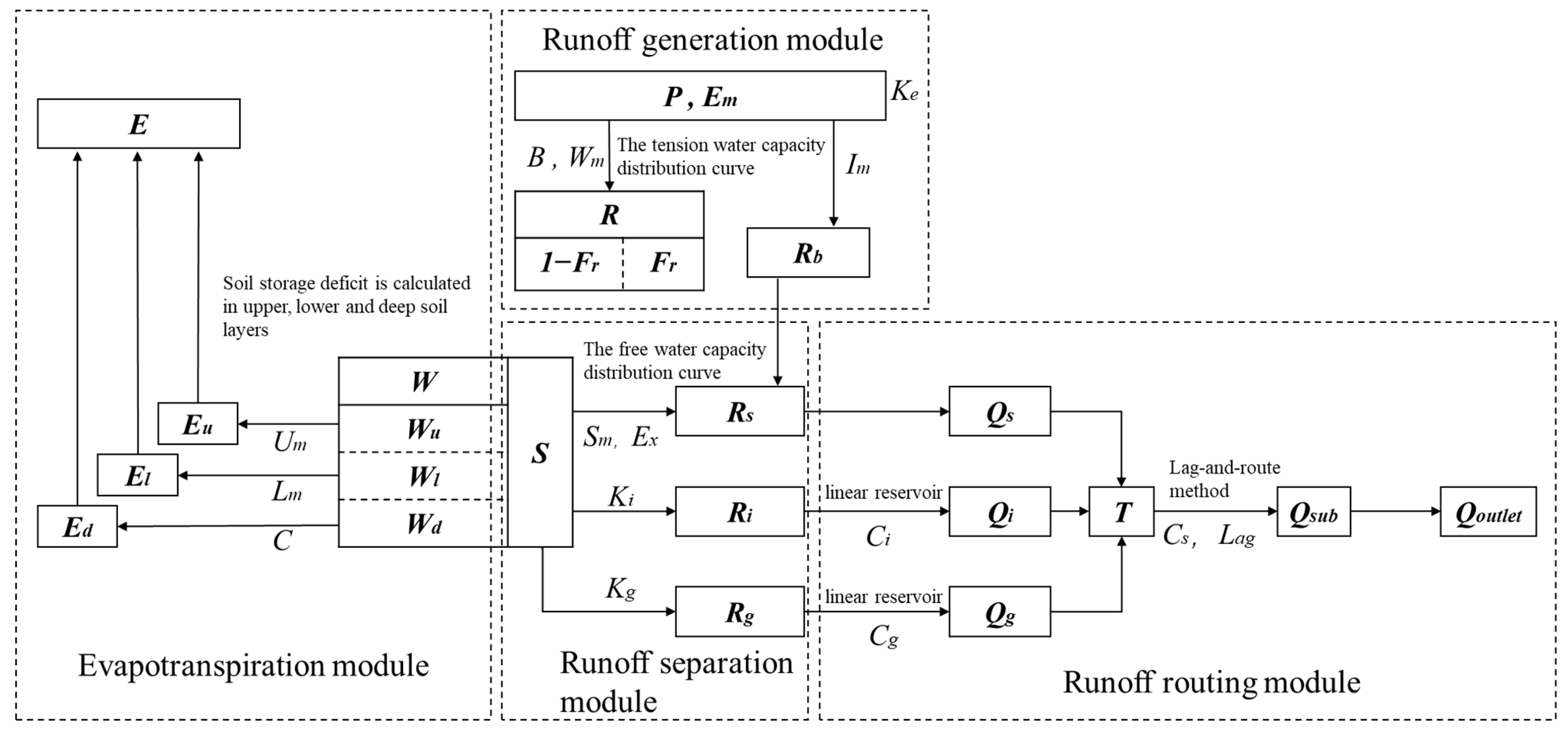
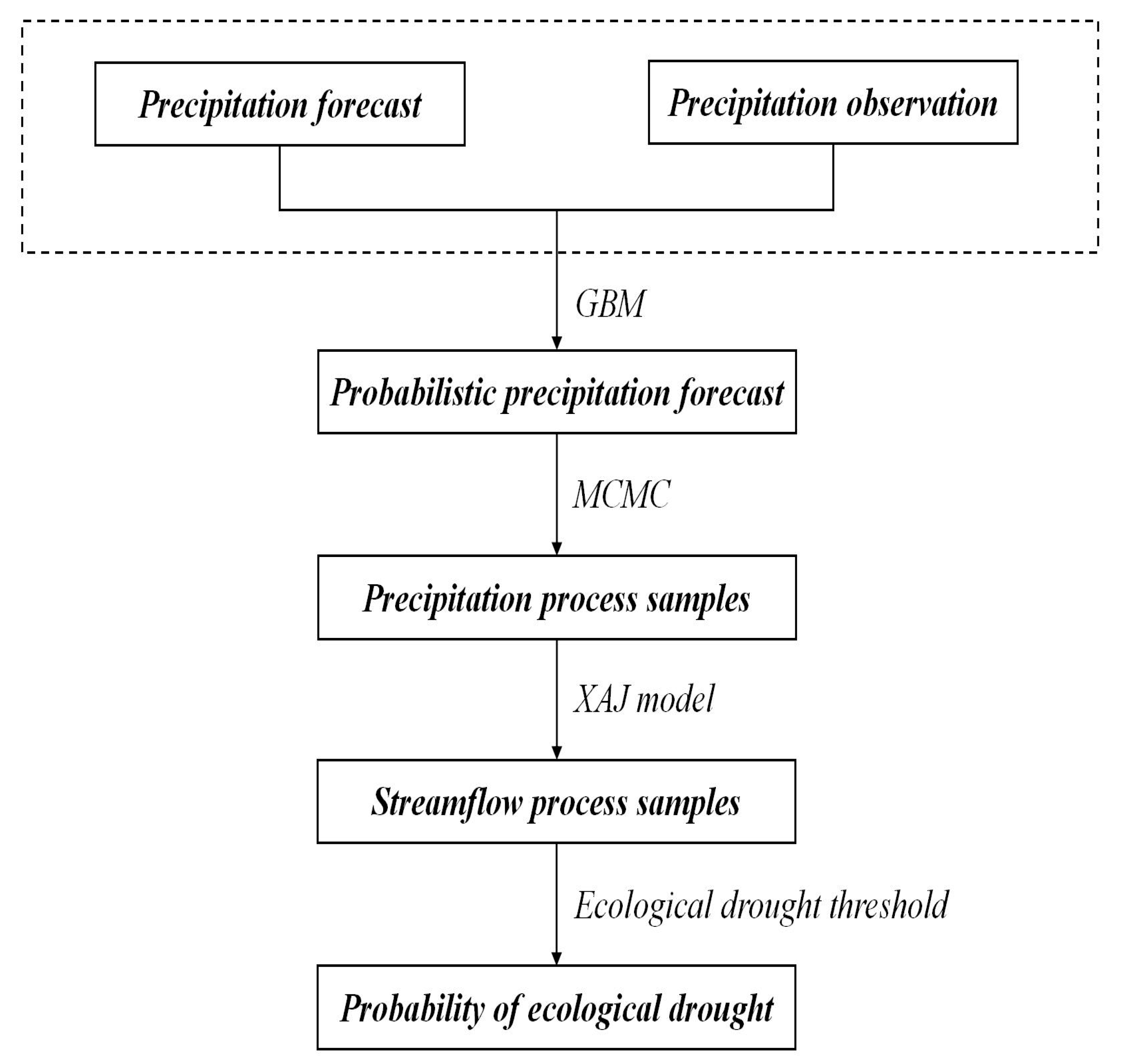
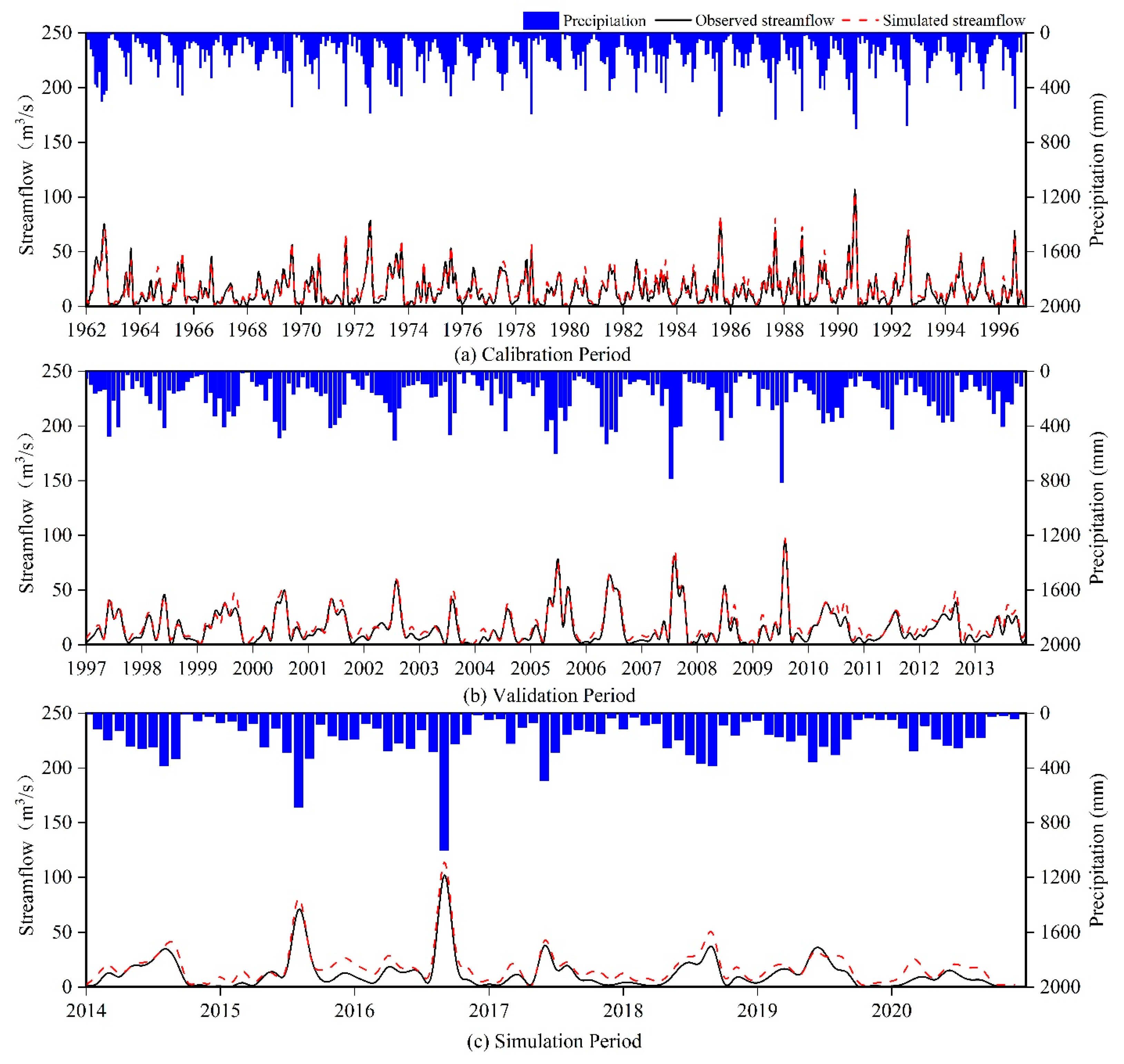
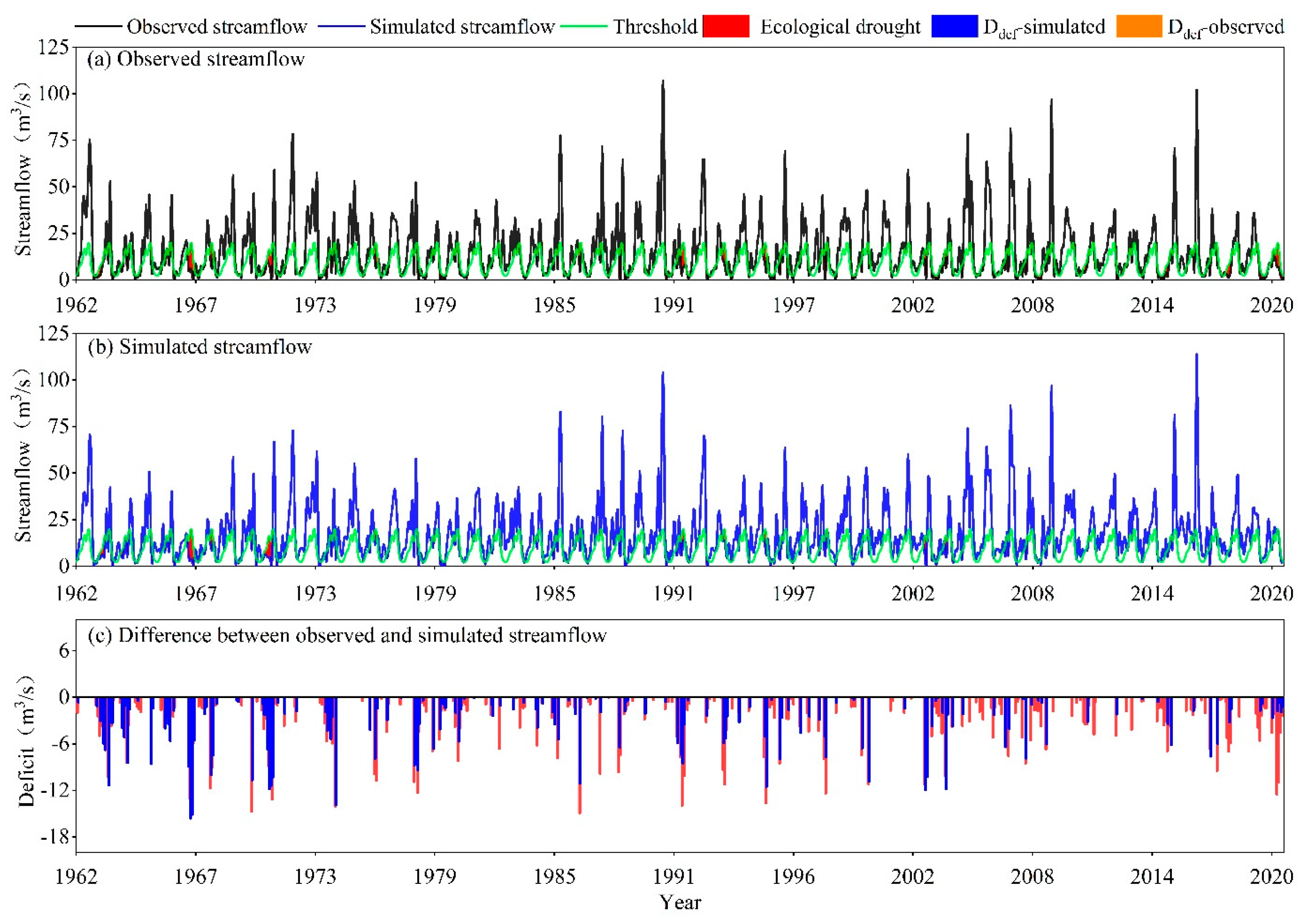

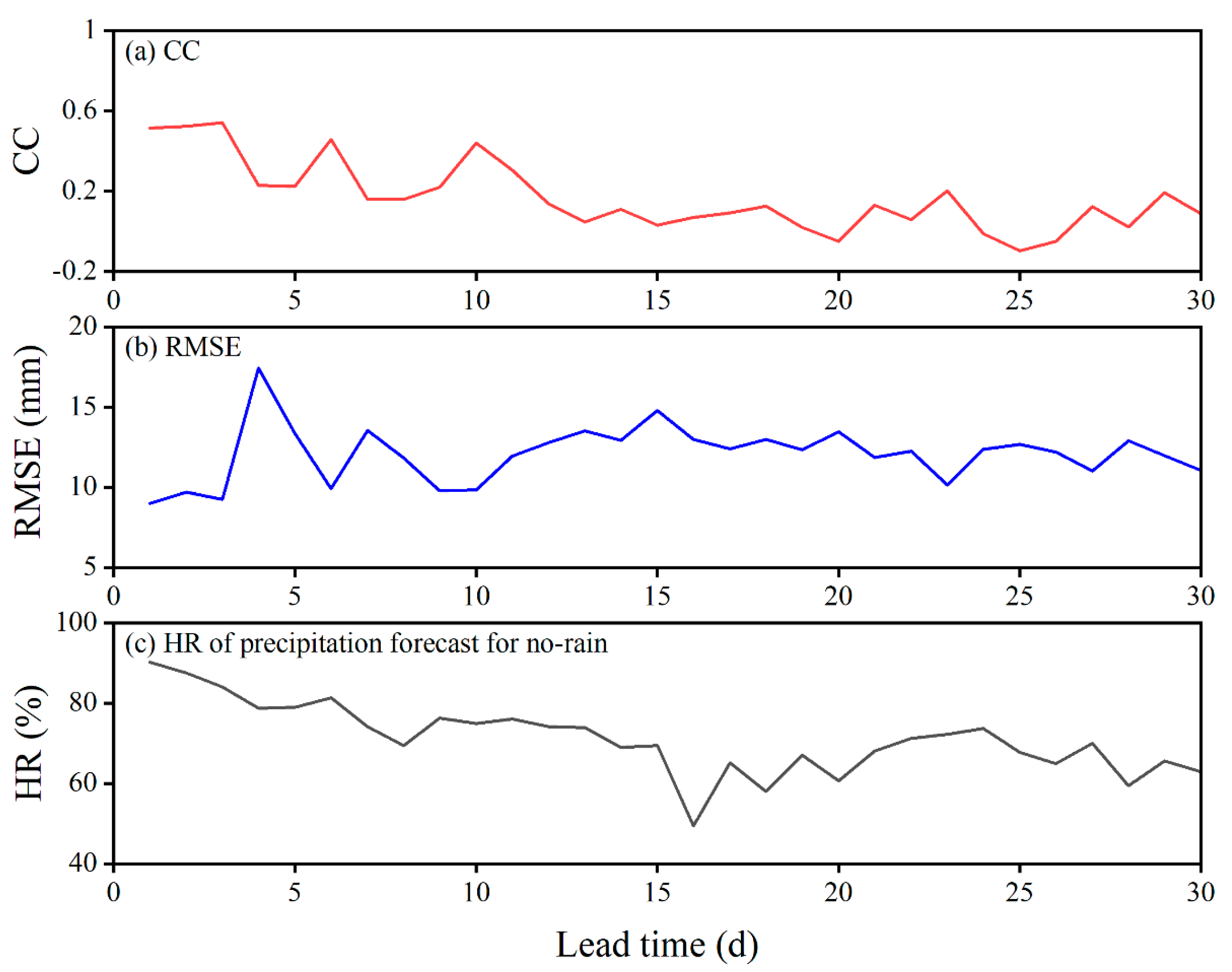
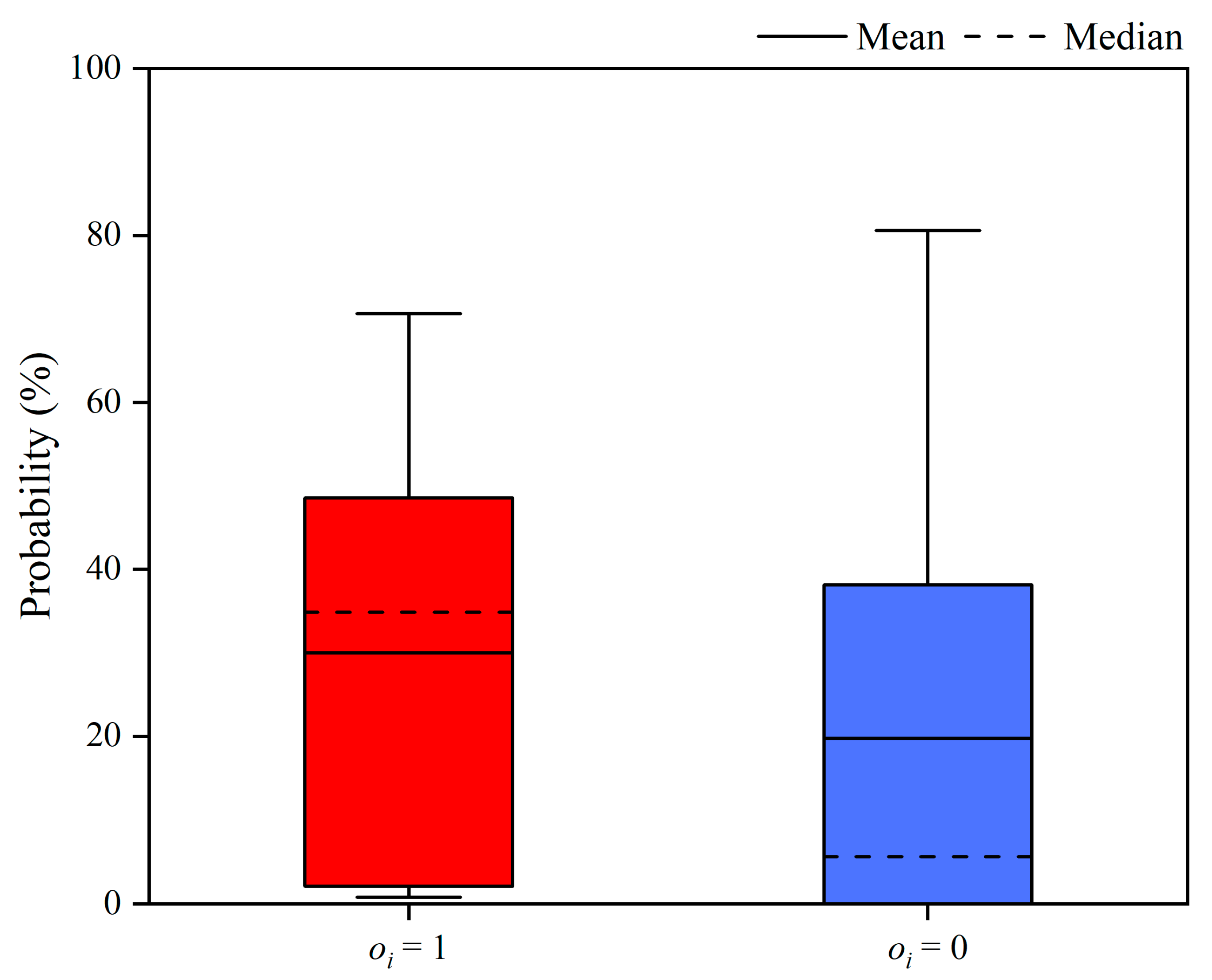
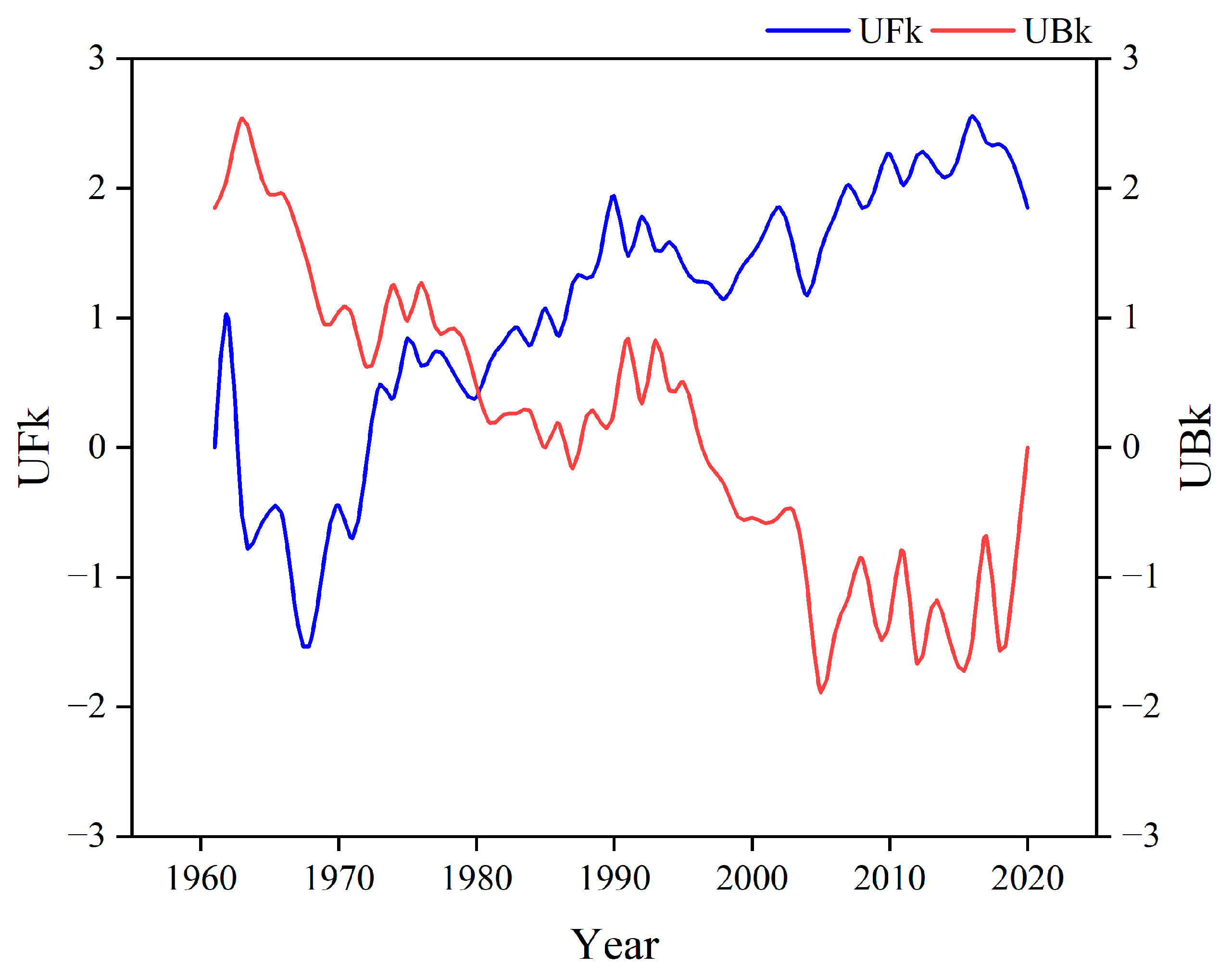
| Category | Variable | Description |
|---|---|---|
| Input variables | Areal mean rainfall depth in the catchment | |
| Areal mean pan evaporation in the catchment | ||
| Model parameters | Ratio of potential evapotranspiration to pan evaporation | |
| Exponent of distribution of tension water capacity | ||
| Tension water capacity | ||
| Ratio of impervious area to the total area of the catchment | ||
| Tension water capacity of upper layer | ||
| Tension water capacity of lower layer | ||
| Evaporation factor | ||
| Areal mean free water storage capacity | ||
| Parameter for the distribution of free water storage capacity | ||
| Contribution to interflow storage; | ||
| Contribution to groundwater storage | ||
| Interflow reservoir constant | ||
| Groundwater reservoir constant | ||
| Route parameter of the flow concentration | ||
| Lag parameter of the flow concentration | ||
| State variables | Runoff from the previous area, having components , , and surface, interflow, and groundwater runoff | |
| Runoff producing area | ||
| Runoff from the impervious area | ||
| Total tension water storage, | ||
| Tension water storage of upper layer | ||
| Tension water storage of lower layer | ||
| Tension water storage of deepest layer | ||
| Total evapotranspirations from soil, | ||
| Evapotranspirations from the upper soil layer | ||
| Evapotranspirations from the lower soil layer | ||
| Evapotranspirations from the deepest soil layer | ||
| Areal mean free water storage | ||
| Surface runoff | ||
| Interflow runoff | ||
| Groundwater runoff | ||
| Discharge from surface runoff | ||
| Discharge from interflow runoff | ||
| Discharge from groundwater runoff | ||
| Total discharge at calculation unit | ||
| Total discharge at outlet |
| Period | NSE | KGE | CC |
|---|---|---|---|
| Calibration (1962–1996) | 0.94 | 0.91 | 0.97 |
| Validation (1997–2013) | 0.91 | 0.80 | 0.97 |
| Simulation (2014–2020) | 0.76 | 0.50 | 0.90 |
| Forecast Method | Deterministic Forecast | Probabilistic Forecast |
|---|---|---|
| BS | 0.35 | 0.18 |
Disclaimer/Publisher’s Note: The statements, opinions and data contained in all publications are solely those of the individual author(s) and contributor(s) and not of MDPI and/or the editor(s). MDPI and/or the editor(s) disclaim responsibility for any injury to people or property resulting from any ideas, methods, instructions or products referred to in the content. |
© 2024 by the authors. Licensee MDPI, Basel, Switzerland. This article is an open access article distributed under the terms and conditions of the Creative Commons Attribution (CC BY) license (https://creativecommons.org/licenses/by/4.0/).
Share and Cite
Cai, C.; Hua, Y.; Yang, H.; Wang, J.; Wu, C.; Wang, H.; Shen, X. Probabilistic Forecast of Ecological Drought in Rivers Based on Numerical Weather Forecast from S2S Dataset. Water 2024, 16, 579. https://doi.org/10.3390/w16040579
Cai C, Hua Y, Yang H, Wang J, Wu C, Wang H, Shen X. Probabilistic Forecast of Ecological Drought in Rivers Based on Numerical Weather Forecast from S2S Dataset. Water. 2024; 16(4):579. https://doi.org/10.3390/w16040579
Chicago/Turabian StyleCai, Chenkai, Yi’an Hua, Huibin Yang, Jing Wang, Changhuai Wu, Helong Wang, and Xinyi Shen. 2024. "Probabilistic Forecast of Ecological Drought in Rivers Based on Numerical Weather Forecast from S2S Dataset" Water 16, no. 4: 579. https://doi.org/10.3390/w16040579





